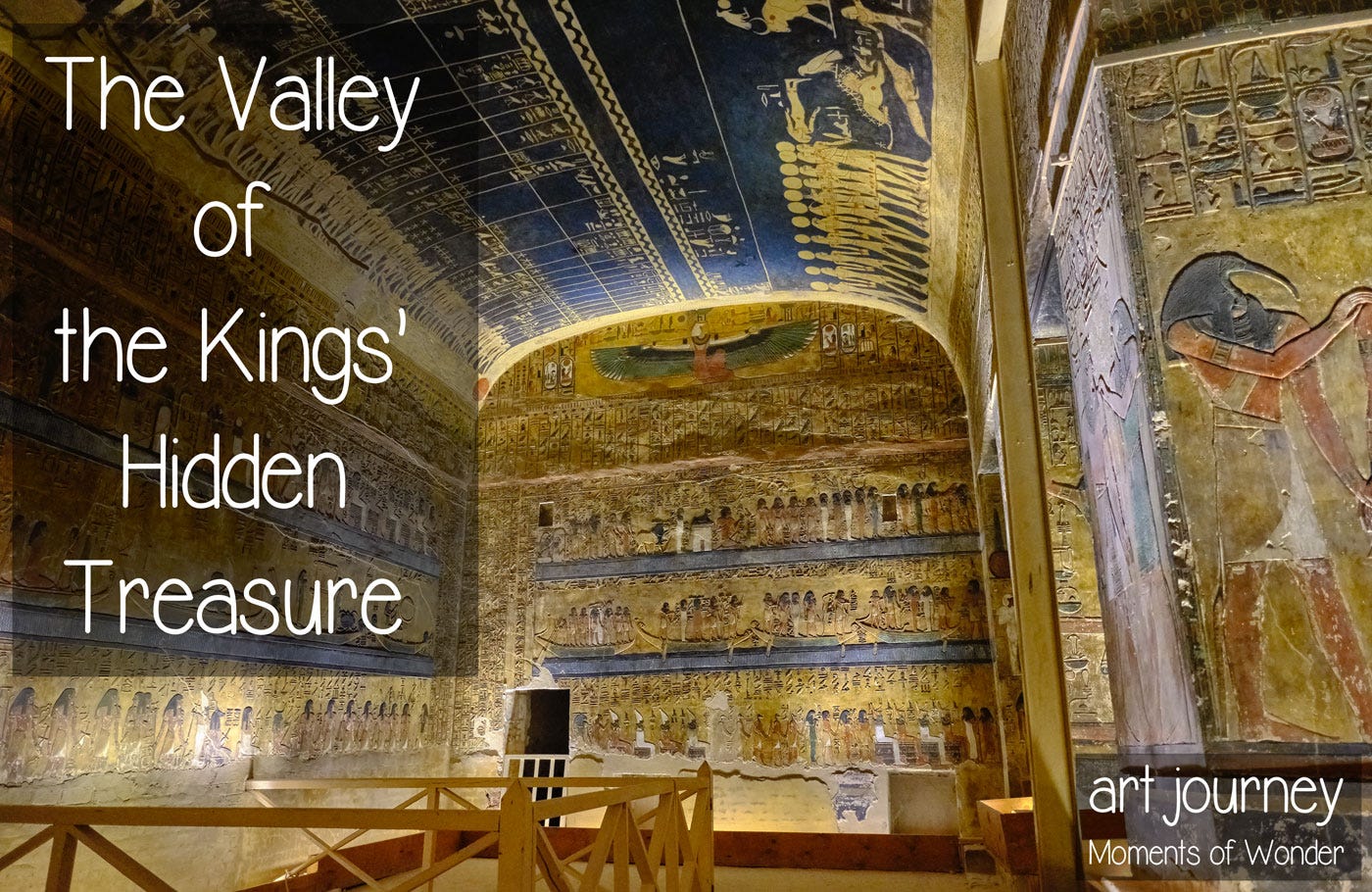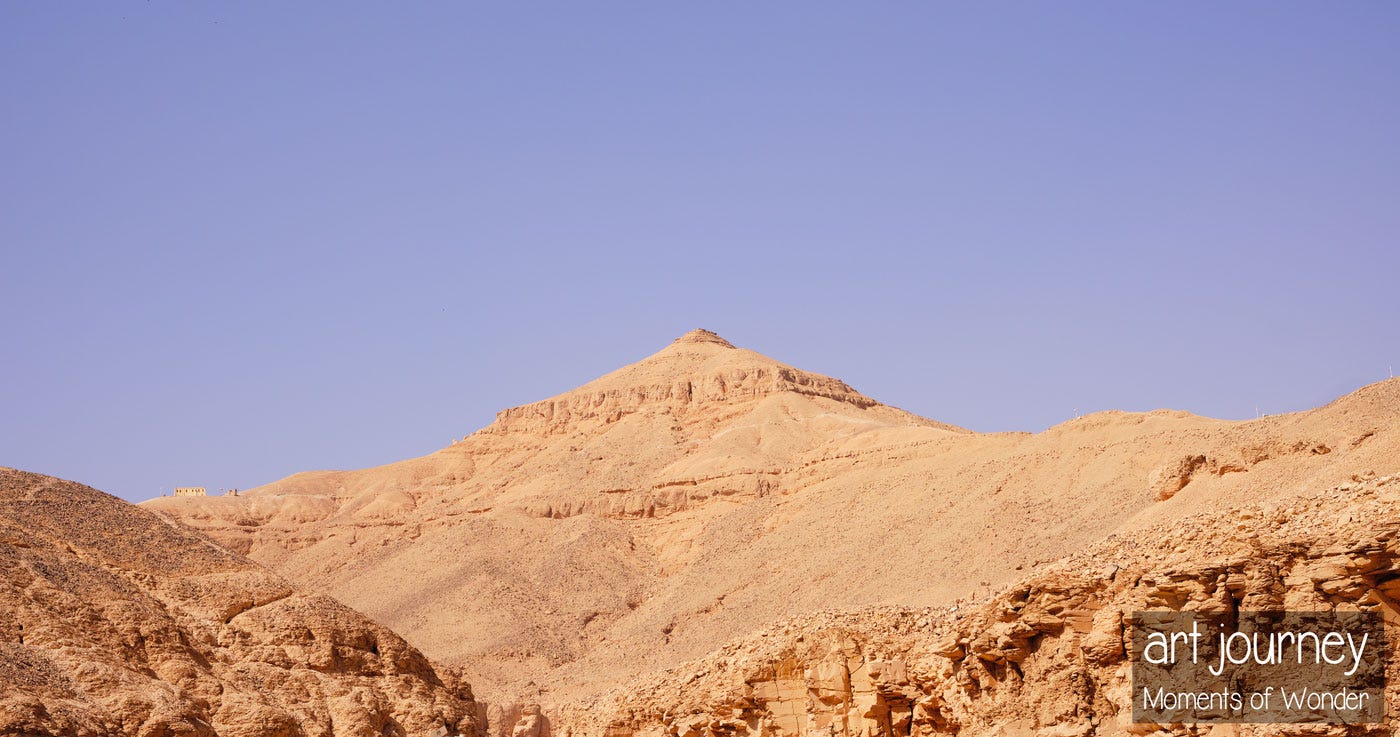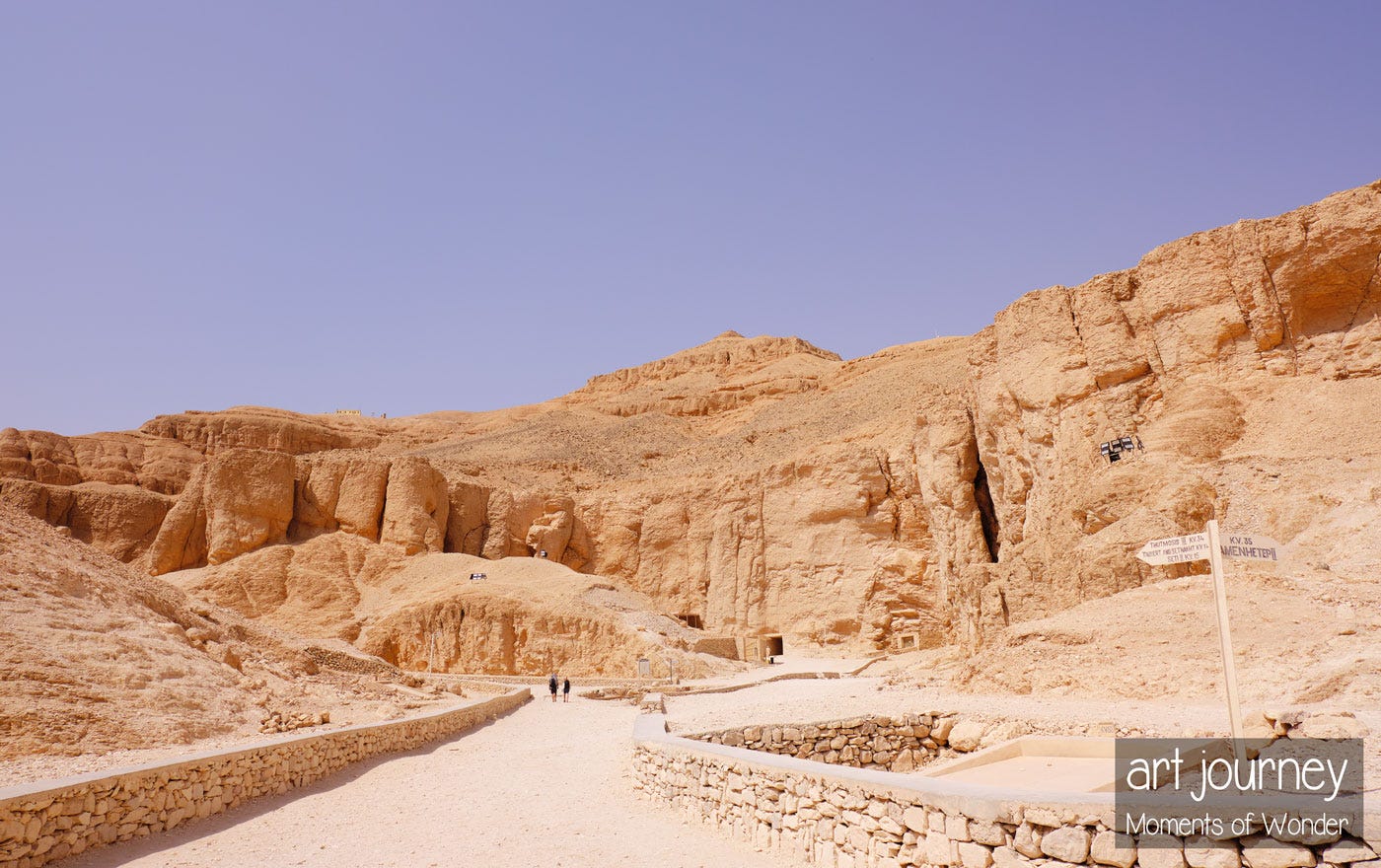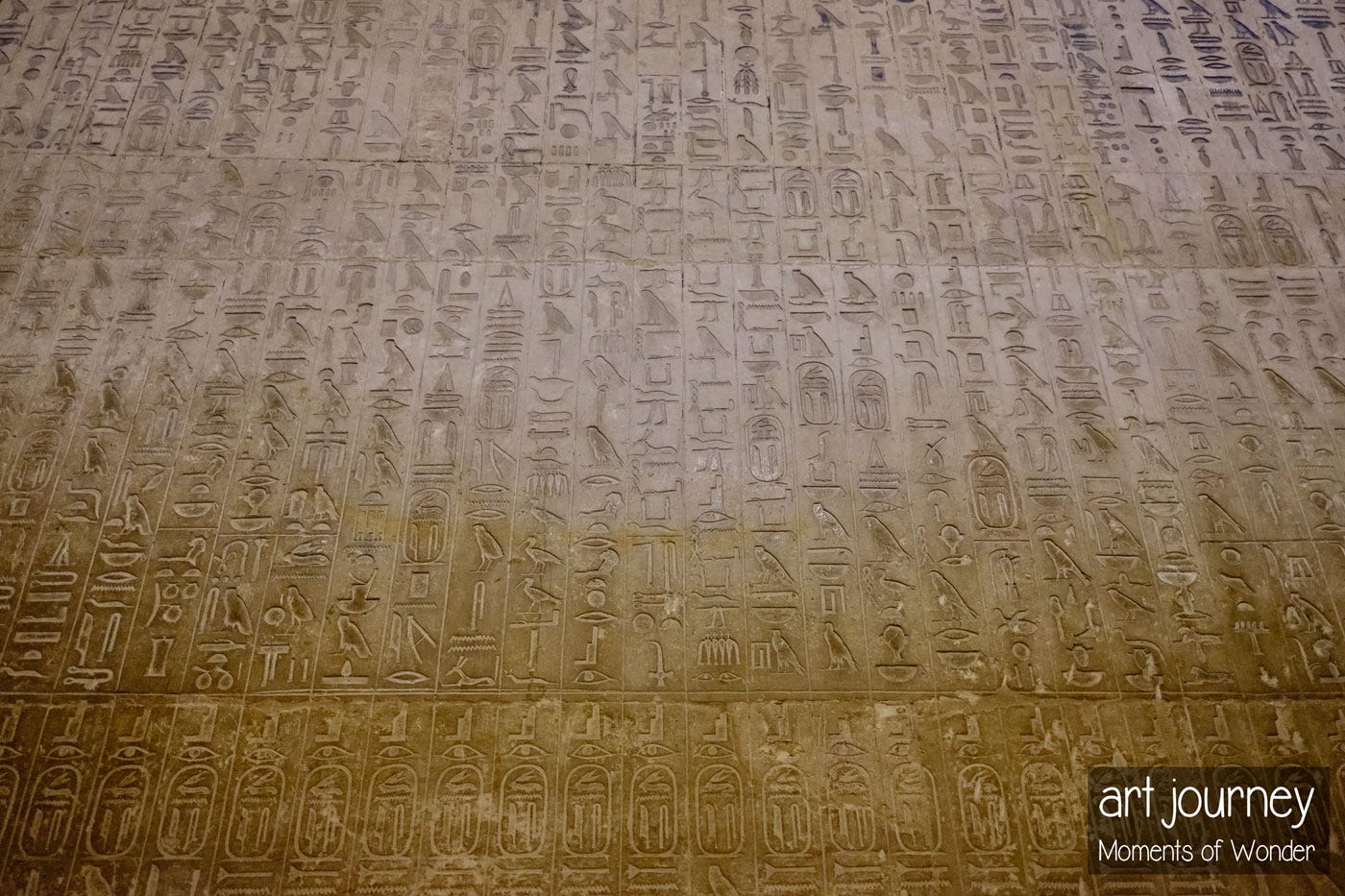The Valley of the Kings' Hidden Treasure Pt 1.
Discovering the tomb of Seti I, the wonder of Egypt missed out by Nile cruises.
Dear reader, our little stories are meant as travels back in time to meet artists and wonder at their achievements. But it involves a bit of imagination, as these people are long gone. Yet, sometimes, we only need a plane or train ticket for a Moment of Wonder.
The Hidden Treasure in question is concealed deep inside the pyramid-shaped mountain in Luxor, Egypt.
Do not pack up your desert shoes and shovel yet. Our treasure had escaped the attention of thieves for three millennia, so it is not easy to find. While exploring that rocky mountain, if you worry about cobras or scorpions, worry instead about the blistering sun.
I tell you that from experience, dear reader. My younger, stupid self did climb that mountain at the peak of summer, at midday.
I am still surprised I did not end up in a display case in the Egyptian museum as a strange mummified body wearing spectacles. That would indeed be proof that the ancient Egyptians also invented eyeglasses!
There's more helpful knowledge about what not to do coming next. I have been fortunate to visit Egypt regularly for over a quarter of a century. On nearly every occasion, I stayed for one month. It was a real luxury not to rush from one place to another and take my time.
That also gave me plenty of opportunities to do stupid things, so you shouldn't have to do them yourself!
For example, another dumb idea was to swim in the Nile. The danger is not crocodiles—stopped by the Aswan dam—but germs. I will spare you the details, but don't do it.
Attempting to discover the treasures of Egypt
On television, all documentaries about Egypt give you a flyover of the Great Pyramid, zoom in on Tutankhamun's gold mask, and show one or two temples, making it look like discovering the wonders of Egypt is easy.
That is how another plan of mine was, on the face of it, not entirely silly. I aimed to see all the temples and all the major tombs in Egypt. It could not be that difficult, could it?
Allow me to tell you the truth, dear reader. So far, I have done, in total, about 9,000 miles of travel in broken-down taxis, trains, and private chauffeurs. Would you agree that that's a fair amount of exploration along the Nile?
And I am still far from having seen everything! Let me give you an idea of the task ahead. Just in a three-mile piece of land in Luxor, around the mountain that hides the Valley of the Kings, there are:
- 64 tombs in the Valley of the Kings.
- over 100 tombs in the Valley of the Queens and nearby wadis.
- about 450 nobles and artisans' tombs.
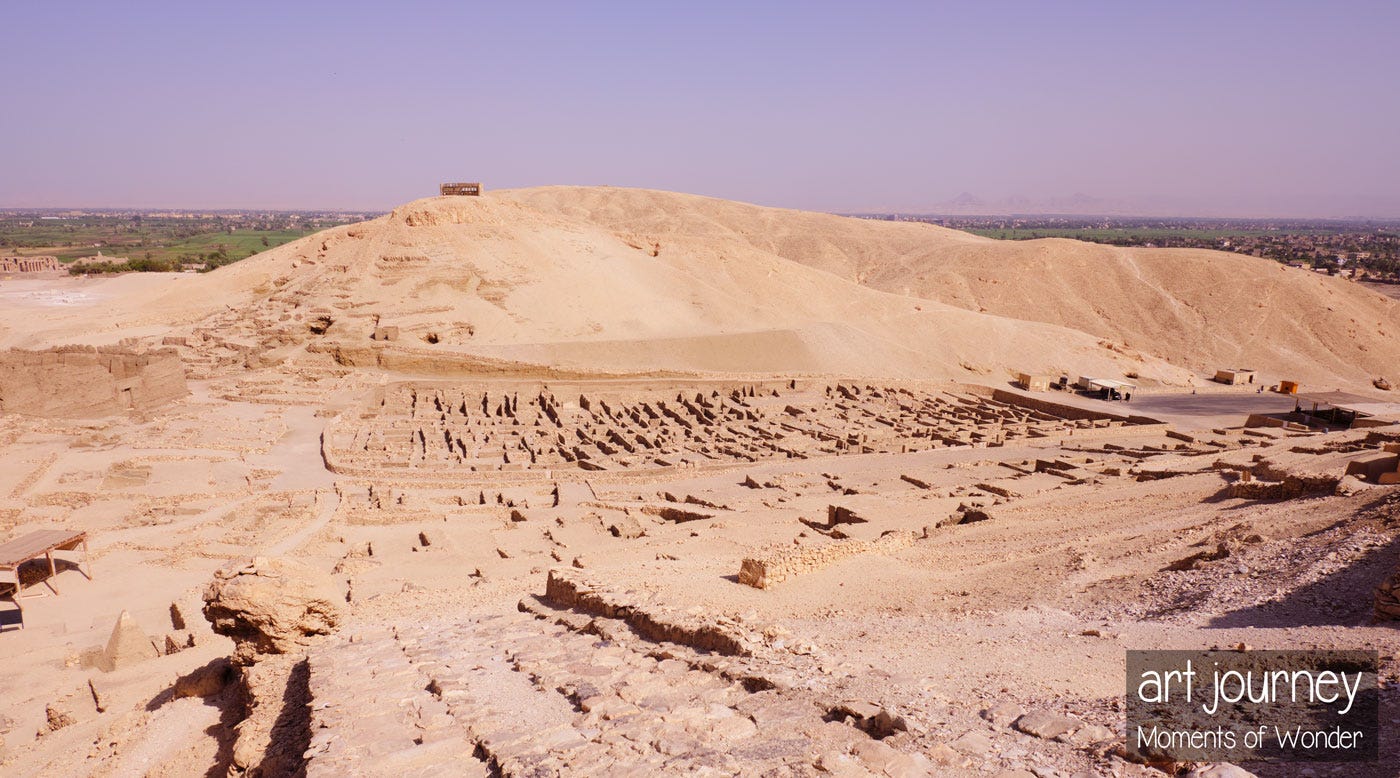
In other words, if it were possible to visit all these tombs, and we had five minutes per tomb, doing it for eight hours straight, it would take over one week of non-stop visits to see them all.
We haven't even paid attention to the temples yet, one of which is the largest in Antiquity. In other words, where do we begin?
How to choose between famous and important sites
When we read a restaurant menu, we choose familiar items and skip the strange ones we have never heard of. It is perfectly natural.
So, when the menu on offer is the Valley of the Kings, with a dozen names to choose from and some tombs pricier than others, what names do we recognize?
There are many different Ramses' tombs: Ramses I, Ramses III, Ramses IV, Ramses V, Ramses VI, and Ramses IX… but not the famous one, Ramses II.
Another name easily stands out is Tutankhamun, since documentaries repeatedly tell us he is the most famous Pharaoh.
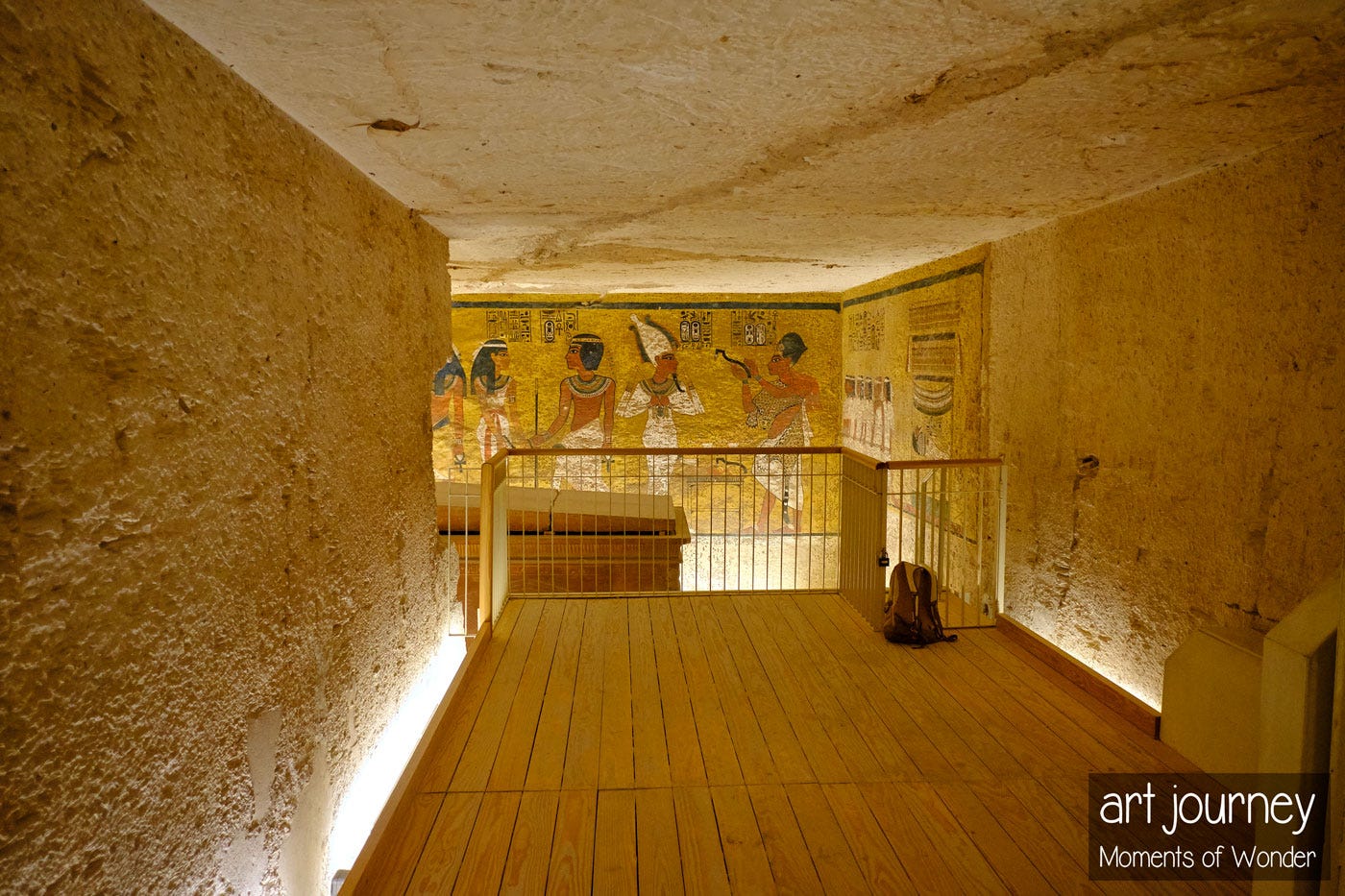
So, we put it on top of our list without realizing that the tomb is tiny. Don't think it will be empty, as you can see in my photos. That is not at all what most visitors experience. For many, the view is a queue outside in the sun to enter a small tomb that is even hotter than the outside.
Between the suffocating atmosphere and the race to see Egypt's treasures, there is only time to peek at the painted wall and Tutankhamun's mummy, to rush out again, sweaty, huffing and puffing.
When I mention it is a race, dear reader, it is because it is, for most visitors, a marathon. While Nile cruises are marketed as the romantic way to visit Egypt, the reality is that they only give one day or one day and a half to discover Luxor.
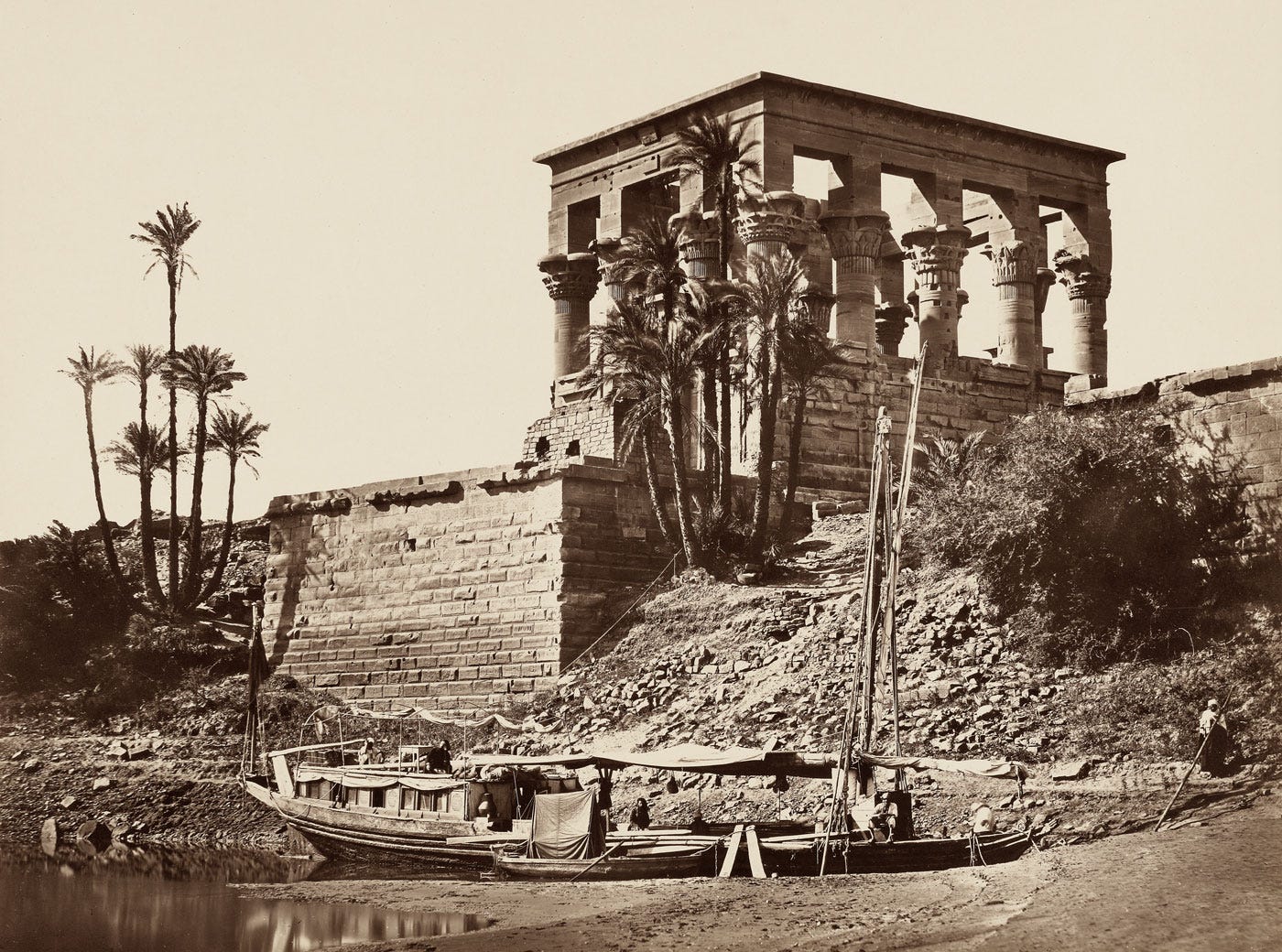
Most Nile cruise companies market themselves as providing a similar experience to early travelers to Egypt. The reality is that going down the Nile to visit the sites between Cairo and Abu Simbel took two months by sailboat or one month by steamboat.
It is impossible to have a similar experience in five days or to discover three millennia of monuments along 700 miles in seven days.
The cost of trying to do what needs one month in one week is missing out on many of the wonders one has dreamt of visiting. That is the unspoken reality of discovering the Treasures of Egypt; it cannot be done in a rush.
Missing out on the memory of a lifetime
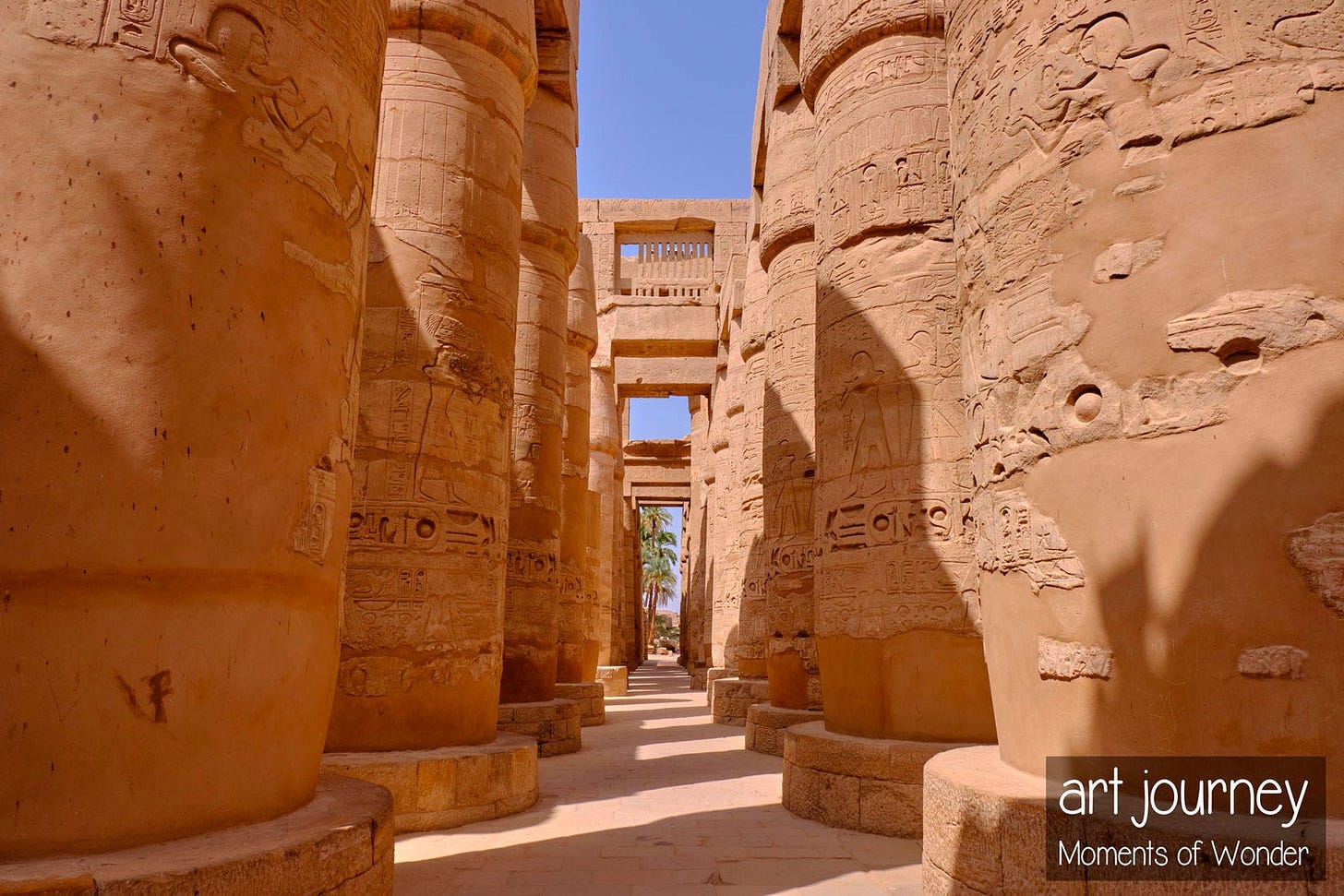
That is where the risk of a colossal disappointment is. Returning home, watching a documentary, or reading a book, and realizing you have missed sites you dreamt of visiting for years.
In Luxor, you have the largest temple of Antiquity, Karnak, along with half a dozen temples to visit, plus the Valley of the Kings and nearby tombs.
It is a race, as cruises arrive simultaneously and have the same program of visits. So you only see a handful of sites, all at the most crowded time of the day, with the pressure of rushing from one to another. The wait of a lifetime ends in regret instead of wonder.
All you get is frustration from missing out on the memories of a lifetime. Instead, here we discover the hidden treasure missed by cruises and people unaware of the real wonders of Egypt.
The Most Beautiful Royal Tomb of Ancient Egypt, KV17, Seti I

Dear reader, have you heard the name Seti before? He is not as famous as Tutankhamun, but:
- he is Ramses II's father.
- he built most of Karnak's colonnade, one of Egypt's most impressive monuments.
- he built—subject to a future story—what may be considered the most beautiful temple of Egypt, another Hidden Treasure.
His tomb is the largest in the Valley of the Kings that is open to the public. That is precisely the point of this story: it is not exactly an obscure Pharaoh. In quantity and quality, it is a far more impressive wonder than the famous one.
Let's now visit the most impressive royal tomb in Egypt.
Hidden inside a natural pyramid
As will be explained in future stories, pyramids are, among other things, giant staircases meant to propel the Pharaoh buried inside to the stars to ensure his eternal life. The confusing thing about pyramids is that they have little to no interior decoration.
One thousand years after the Pyramid Age, Luxor was the capital of Egypt, and there was a natural pyramid there. The mountain on the West side of the Nile was a perfect location, as the West is the entry to the afterlife. The rocky hill also offered another advantage: hiding the kings' tombs from thieves.
A specialist team carved and decorated the tombs and hid the entrance while soldiers patrolled the Valley. Previously, the effort was to build a colossal pyramid, but the construction work was already on the mountain this time.
A springboard to the starry sky
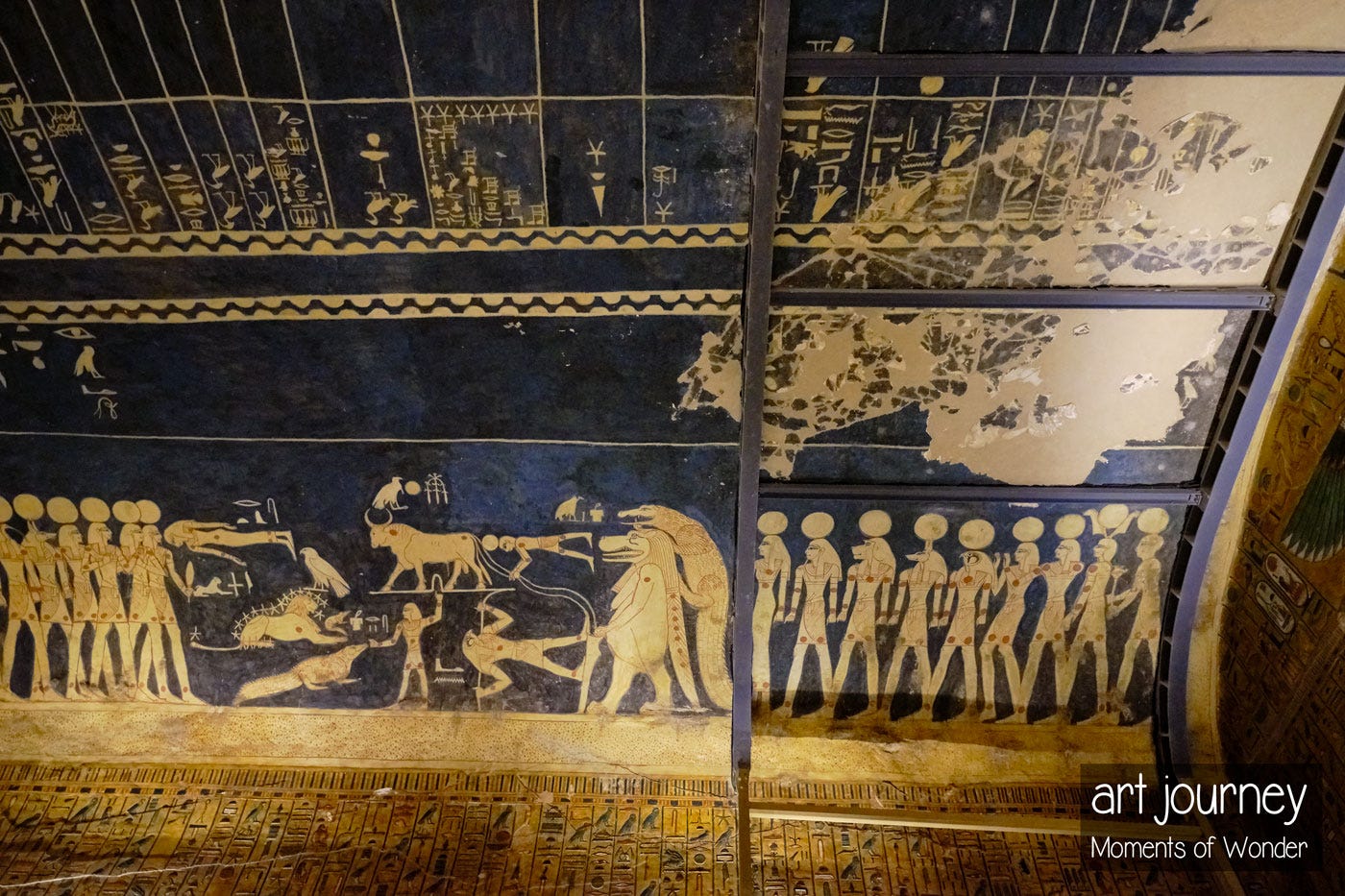
To appreciate the importance of what we are looking at, the photo below is of the oldest religious text in the world, about 4,300 years old, inside the pyramid of Pharaoh Unas.
Now imagine that 1,000 years later, when the Pharaohs ruled from Luxor and carved the mountain into the Valley of the Kings, the walls were covered with carved and painted images instead of just text.
It feels like switching from black-and-white silent movies to vivid Technicolor. It is also how, instead of feeling claustrophobic, the burial chamber is open to the starry sky above the mountain, so Seti I could join the eternal stars at night.
If Egyptologists and art historians were asked to choose the artistic peak of ancient Egyptian art within three millennia, many would choose the New Kingdom, the age of Ramses II, Tutankhamun, and much more.
In the next part of the story, we will discuss the tomb's discovery, how the walls were pristine, and how, unfortunately, they were damaged.
In the meantime, feast your eyes with the photos of this marvel, for a Moment of Wonder.





